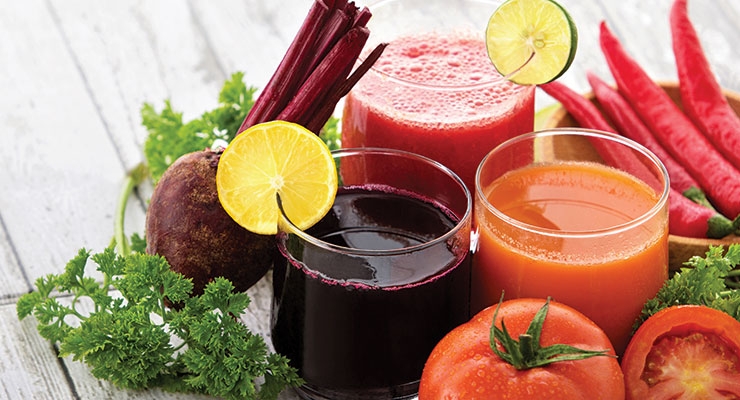Features
Insights On Antioxidants: Keys to Future Development
Natural and whole food ingredients continue to propel the category forward.
By: Lisa Olivo

Antioxidants—the free-radical scavenging molecules well known for supporting a range of health indications—are now considered common and established tools in the fight for better health. While the term “antioxidant” was once seen as a trendy buzzword, today, scientifically validated, carefully crafted ingredients have emerged to solidify their stance in the health and wellness sector.
Although Mintel’s Global New Products Database reported just 2% of product launches in the U.S. in 2014 promoted antioxidants as an ingredient, that doesn’t mean growth in the market has stagnated. Rather, savvy marketers and manufacturers have redefined their message to provide consumers with more targeted and specific information on the scientifically-proven benefits that antioxidant ingredients provide for cardiovascular health, skin and anti-aging, immunity, eye health and more.
A huge factor in propelling this market forward lies in the natural appeal of antioxidants. While synthetic varieties still make up a portion of the ingredient market, natural antioxidants are spurring growth in the category, accounting for more than 30% of the overall market, according to Future Market Insights. In fact, thanks to robust sales among natural antioxidants, the global market is expected to grow at a CAGR of 5% through 2020.
Grand View Research, Inc. predicted the global antioxidants market will reach $4.14 billion by 2022, attributing growth to prevalence in personal care products for skin and hair, as well as increased usage in fortified foods. The market research firm also underscored that growing consumer awareness of the benefits of natural antioxidants will continue to fuel the category.
“Consumers are now becoming knowledgeable and browsing past synthetic vitamins that contain antioxidants,” observed Margaret Gomes, marketing director with Nature’s Power Nutraceuticals Corp. (NP Nutra), Gardena, CA. “Whole food antioxidant supplements are more appealing to people as they become aware of where their supplement sources come from, and how they affect the body.”
As educated consumers continue to pursue clean-label, natural and clinically proven antioxidant ingredients, leaders in the nutraceutical space are stepping up to meet the demands of this burgeoning audience.
Reaping the Benefits
While some experts worry ubiquitous antioxidant claims have diluted this already saturated market, there’s no denying a powerful media message has increased consumer understanding.
“Like it or not, the media drives awareness (whether true or not) about everything consumers put in their mouths,” commented Lisa Mack, director of sales and marketing, Connoils LLC, Waukesha, WI, especially when consumers are trying to align a health concern with a food group or ingredient. “Today every health ailment has a ‘magic bullet’ food or product that will drive consumers to flock to purchase. Antioxidants being labeled ‘superfoods’ was a brilliant catch phrase for fighting low immune systems, anti-aging, weight loss, etc.”
Aparna Kalidindi, PharmD, BCPS, sales and marketing manager with Natreon, Inc., New Brunswick, NJ, attributed the spike in interest in antioxidants to the rise in chronic disease in the U.S. “Consumers want to fight off chronic disease and signs of aging with a more natural approach,” said Dr. Kalidindi. “This has led to the increase in use of antioxidant rich foods and supplements for cardiovascular disease, bone and joint disease, eye health, immune health, and even visible signs of aging. Most of these consumers are the Baby Boomers who are trying to prevent or mitigate these chronic diseases.”
The stressful nature of modern life can also negatively impact health, resulting in oxidative stress in the body, according to Shaheen Majeed, marketing director of Sabinsa Corporation, East Windsor, NJ. “Our modern day lifestyle is stress ridden and leads to a number of unnecessary health disorders. Depending on the magnitude and duration of stress, the body manifests this differently. The fundamental source traced to most stress-caused chronic conditions is the production of free radicals.”
Unhealthy physical and environmental stressors, ranging from chemical exposure to pollution to cigarette smoking and drug use, all negatively impact health. Consumers struggling with these stressors could benefit from antioxidant foods and supplements, Mr. Majeed added.
Simply getting older also adds to oxidative stress in the body, which is why the growing aging population is turning to antioxidant foods and supplements for support. “In a healthy person, regulators of oxidative stress and inflammation are in balance. However, in most diseases states, especially age-related diseases, this balance is shifted toward oxidative stress and inflammation with more reactive oxygen species production,” explained Jeff Wuagneux, president and CEO of RFI, Blauvelt, NY.
Health-conscious consumers in the aging demographic are in most cases very aware of the link between aging and oxidative stress, and as a result are turning to antioxidant-rich foods and supplements for support, Mr. Wuagneux noted. “You can see this in one simple measurement: the huge increase in sales of kale, mostly because people believe kale is chock full of antioxidants.”
He also referenced mounting scientific evidence linking oxidative stress and inflammation. “For instance, vascular inflammation and endothelial dysfunction are both a result of oxidative stress, leading to cardiovascular disease, or diabetes, where insulin resistance is associated with systemic inflammation and increased oxidative stress. Even neurodegenerative diseases such as Alzheimer’s and Parkinson’s have a link between the two. So the truth is, what heath objectives are not associated with need for antioxidants?”
Younger consumers are looking to antioxidants for support as well, according to Ms. Gomes of NP Nutra. “Millennials are all about everything healthy, and are really careful about what they put into their bodies, so they are probably eating more nutrient-rich foods.”
Even the beloved family pet can benefit from an antioxidant boost in their diet, according to Ms. Mack. Some studies show consumers are more likely to pay higher prices supporting their pet’s health and wellness than their own, she suggested. “The health and wellness industry is exploding and not just for humans. Consumers are also spending billions of dollars on their pets—from keeping their coat nice and shiny, making their food more palatable, managing weight gain and stemming the risk of cancer.”
Emerging Ingredients
Antioxidant ingredients derived from nature are bountiful within the category, as consumers gravitate toward recognizable and sustainably sourced health products.
Bruce Abedon, PhD, director of scientific affairs for NutraGenesis, Brattleboro, VT, explained that while vitamins A, C and E are mainstays, botanicals such as resveratrol or “superfruits” like blueberry, acai and mangosteen also represent powerful players. Curcumin, he observed, has become popular despite some issues related to bioavailability.
Dr. Abedon also pointed to MycoFusion mushrooms—grown on high anthocyanin purple corn as the substrate—as emerging antioxidant ingredients. MycoFusion mushrooms, he said, “include either maitake, shiitake, reishi, cordyceps, agaricus, lion’s mane, or chaga mushrooms, which are grown in a unique process that results in the fusion and incorporation of high antioxidant anthocyanin phytonutrients together with mushroom bioactives such as beta-glucans to form super-nutrient complexes.”
RFI’s whole foods garlic powder, FermaPro Black Garlic, is also graining traction in the antioxidant market. Thanks to RFI’s proprietary “double fermentation” method, FermaPro Black Garlic is rich in S-allyl cysteine (SAC), as well as tetrahydro-beta-carbolines, which the company said are structurally similar to flavonoids.
The SAC in black garlic is considered an “antioxidant superstar” as a result of studies suggesting its support in preventing or ameliorating oxidative stress, as well as inhibiting oxidation of lipids and proteins.
A comprehensive review of SAC and black garlic published in Oxidative Medicine & Cell Longevity in 2012 reaffirmed FermaPro Black Garlic’s antioxidant potency. Results of the study confirmed SAC and black garlic’s ability to scavenge free radicals, including superoxide anion, hydrogen peroxide, hydroxyl, peroxynitrite radicals as well as hypochlorous acid and singlet oxygen. The report also demonstrated SAC and black garlic’s ability to induce the activity of endogenous antioxidant enzymes such as glutathione peroxidase, NAD(P)H:quinone oxidoreductase, and superoxide dismutase (SOD); chelate iron and copper ions; and inhibit pro-oxidant enzymes such as nitric oxide synthase (NOS), xanthine oxidase, NADPH oxidase and cyclooxygenase (COX).
Connoils offers a variety of antioxidant ingredients from natural sources, many with the ability to maintain shelf stability in finished products. Michelle Coluccio, director of new product development, explained that many of the products the company offers “have their own natural antioxidants helping them maintain their stability, including those rich in fat-soluble vitamin E like wheat germ, safflower and sunflower oils and oil powders for supplements.” She continued, “Modern engineering and science have introduced ways to process plant-derived ingredients so they maintain their ‘natural’ antioxidants to support a longer shelf life and ideally can be passed along to the body once consumed. Products rich in carnosic acid, like rosemary extract, have been proven to be even more capable than A, C and E as antioxidants, natural preservatives and natural bacteria inhibitors.”
Golan Raz, vice president of the Health Nutrition division at Lycored, Orange NJ, noted several tried and true antioxidant ingredients that continue to appeal to product developers and consumers: “resveratrol from grapes, lycopene form tomatoes, lutein from marigold flowers, astaxanthin from algae, grape seed extract, CoQ10, green tea, blueberry and others.”
The company recently launched Lyc-O-InVision, a nutrient complex positioned for eye health. The formula includes a rich combination of antioxidants such as standardized tomato extract for lycopene, a carotenoid known for its ability to protect lutein as it is transported to the eye; lutein, an essential antioxidant concentrated in the macula, with benefits for filtering out UV rays and blue light; as well as zeaxanthin, which when combined with lutein helps increase the pigment of the macula, protecting the eye from UV rays and oxidative stress. The formula also features carnosic acid from rosemary extract, tocopherols from vitamin E, as well as copper and zinc.
Leveraging the benefits of lycopene and beta-carotene, Sabinsa provides Lycopene β extracted from Momordica cochinchinensis (Gac). “The red pigment present in tomatoes, apricots, watermelons, guavas, papaya, grapefruits and rosehips that gives them their color is called lycopene,” Mr. Majeed explained. “Tomatoes were considered the largest source of lycopene until Gac, native to Vietnam, was presented worldwide.”
Describing the breadth of research supporting lycopene for its antioxidant capabilities, Mr. Majeed referenced clinical research demonstrating how antioxidant supplementation benefits a healthy lifestyle. “An 8-week human trial conducted with healthy subjects supplemented with 12 mg lycopene/day or a mixture of lycopene with beta-carotene and lutein (4 mg/day each) demonstrated the beneficial effects in countering oxidative DNA damage in their lymphocytes (Zhao et al, 2006).”
An additional study supplemented healthy subjects with lycopene through tomato juice, spaghetti sauce and tomato oleoresin for a period of one week each, and demonstrated a significant reduction in thiobarbituric acid-reactive substances (TBARS), which Mr. Majeed explained is a measure of lipid peroxidation. “Results indicated that lycopene is easily absorbed by cells and thereby it has positive implications in cancer prevention (Rao et al., 1998).”
NP Nutra’s Ms. Gomes underscored the antioxidant potential of ashwagandha for its ability to stimulate the immune system, as well as support mental well-being. “Researchers from Banaras Hindu University, India, and from the Drug Research and Development Center, Calcutta, discovered that some of the chemicals in ashwagandha are powerful antioxidants,” she explained. “They tested its effects on rat brains and found an increase in the levels of three naturally occurring antioxidants.”
Recent scientific research has also catapulted turmeric to be considered one of nature’s most potent superfoods, Ms. Gomes added. Citing a 1999 study published in the Journal Phytotherapy Research, she described results that found “the primary polyphenol in turmeric, the saffron colored pigment known as curcumin, compared favorably to steroids in the management of chronic anterior uveitis, an inflammatory eye disease.”
Sabinsa also offers Curcumin C3 Complex, an extract from the rhizomes of Curcuma longa (turmeric) and standardized for a minimum of 95% curcuminoids. Discussing the benefits of curcuminoids, Mr. Majeed said, “A range of biologically potent actions … have been reported and include antioxidant, anti-inflammatory, anti-aging and immune system support.”
Another ingredient Sabinsa offers is selenium (SeleniumSeLECT), comprised of the amino acid methionine, in which sulphur is replaced by selenium. “Selenium is a micronutrient with a role in various processes encompassing energy utilization, immune mechanisms and antioxidant actions. It also works in synergy with vitamin E to counter lipid peroxidation in cells,” said Mr. Majeed.
Derived from the dried heartwood of Pterocarpus marsupium (Indian Kino), Silbinol from Sabinsa is available in two formats, standardized for 5% and 90% pterostilbene. Pterostilbene has antioxidant and anti-inflammatory properties, and Mr. Majeed said this ingredient displays more stability than its structural analogue resveratrol.
Kyowa Hakko U.S.A, Inc., New York, NY, offers Setria Glutathione, known as the “master antioxidant,” to aid in detoxification and support healthy immune function. Glutathione can be obtained two ways, according to the company: from food and as part of the body’s internal production. A variety of factors including age, health conditions, lifestyle, environment and certain medications deplete the body’s natural stores of glutathione, making supplementation necessary. Setria Glutathione replenishes the body’s natural stores, helping to protect cells from oxidative stress and harmful toxins associated with free radicals, according to the company.
From the Sea
Numerous marine nutraceuticals are rich in antioxidants, with astaxanthin being one of the most notable success stories in this category. A natural carotenoid, astaxanthin is derived from certain marine animals and plants, including microalgae, salmon, krill, yeast and some crustaceans.
Janice Brown, technical sales/support with AstaReal, Inc., Burlington, NJ, suggested astaxanthin is unique in the antioxidant space because unlike other ingredients such as beta-carotene or vitamin C, astaxanthin is able to protect both the inner and outer portions of cells. ”Beta-carotene is lipid-soluble and therefore is only found on the inner portion of the cell membrane. Vitamin C is water-soluble and can only exist on the outer portion of the cell membrane. Astaxanthin has polar ends and lipid double bonds that connect those polar ends, therefore it can span the entire cell membrane,” she explained.
With more than 100 studies conducted on astaxanthin (with half of them performed in human subjects), this carotenoid has emerged as an ingredient for eye health, skin health, muscle endurance and recovery, cardiovascular health, cognitive function and more.
Recently, a double-blind placebo controlled study published in Evidence-Based Complementary and Alternative Medicine (2015) examined the anti-inflammatory effect of AstaReal when administered to elite athletes, with results indicating the ingredient helped improve immune response and reduce muscle inflammation.
In the trial, a group of 40 soccer players were supplemented with 4 mg of AstaReal or placebo for 90 days. The results showed significantly higher levels of (sIgA), an immunoglobulin known to support muscle and immune function, among the athletes given AstaReal. Additionally, researchers found that AstaReal supplementation combined with training decreased the pro-inflammatory biomarker CRP, indicating lower levels of inflammation.
The blue-green algae ingredient spirulina is also noteworthy. Rich in carotenoids, antioxidants and vitamin A, in addition to protein, minerals and dietary fiber, Mintel reported spirulina has emerged as a popular superfood within the health and wellness category. While spirulina is perhaps best known as a vegan source of protein, Mintel reported that 37% of healthcare products containing spirulina boasted its antioxidant capabilities.
Berry Boost
Many berries—some familiar and others more exotic—offer a host of health benefits, with clinical research demonstrating their rich antioxidant content.
A study published in Open Chemistry (November 2015) tested red raspberry (Rubus idaeus), black raspberry (Rubus occidentalis) and blackberry (Rubus fruticosus), grown in central Europe to evaluate phenolic compounds, such as anthocyanins, in addition to antioxidant properties of fruit extracts. Results determined that black raspberries had the largest antioxidant capacity, and contained the most abundant phenolic and anthocyanin compounds. Blackberries had an even larger antioxidant capacity than red raspberry fruits, but red raspberry had a higher content of total phenolics and anthocyanins.
Mintel pointed to research suggesting blackcurrant presents an opportunity for formulators. The research firm reported a 100-gram serving of blackcurrant contains 300% of the Daily Value for antioxidant vitamin C, preventing free radicals from damaging cells.
Mintel added that blackcurrants are high in anthocyanins, a compound adding to the berry’s unique antioxidant profile. It also possesses flavonoids like beta-carotene, zeaxanthin and cryptoxanthin, which are known for their ability to help lower the risk of lung and mouth cancers, protect against neurological diseases, slow the aging process and fight inflammation.
Blueberries are also antioxidant powerhouses, according to the U.S. Highbush Blueberry Council (USHBC), Folsom, CA. Thomas Payne, market development consultant, pointed to findings from USDA’s Economic Research Service, which indicated that Americans’ growing appetite for a healthy and nutritious diet has aided in boosting demand for blueberries.
“Phytochemicals found in fruits, such as blueberries, continue to be investigated for their health benefits in the prevention of a range of diseases, such as cancer, heart disease, urinary tract infection, and even to slow the aging process, including memory loss,” said Mr. Payne. “Studies of older laboratory animals consuming blueberry-supplemented diets have shown measurable improvements in memory, coordination and balance. Research is also uncovering neuron regeneration in older animals fed blueberries.”
In 2012, research published in British Journal of Nutrition found that 75 grams of blueberries could provide statistically significant oxidative protection in vivo after a high-carbohydrate, low-fat breakfast. Though not tested directly, researchers suggested it is likely the effects were due to phenolic compounds, either directly or indirectly, as they are a major family of compounds in blueberries with potential bioactive activity.
Dr. Abedon of NutraGenesis, described the benefits of the standardized Amla extract, or Phyllanthus emblica (Emblica officinalis) marketed as Capros, which is backed by six human clinical trials. He said these studies “demonstrated how Capros’ superior antioxidant properties help support cardiovascular health and provide resistance to the effects of free radicals.”
One of these studies, published in Diabetes, Metabolic Syndrome and Obesity: Targets and Therapy (July 2013), compared Capros against a placebo or atorvastatin (Lipitor) to evaluate its impact on endothelial dysfunction and biomarkers of oxidative stress in patients with type 2 diabetes.
Treatment with 250 mg of P. emblica twice daily, 500 mg twice daily, or 10 mg of atorvastatin saw improvement in endothelial function after 12 weeks of treatment compared with baseline. Researchers also reported a significant improvement in biomarkers of oxidative stress and systemic inflammation compared with baseline and placebo. The results suggested that P. emblica extract may be a good alternative to statins in diabetic patients with endothelial dysfunction because of its beneficial effects without the known side effects associated with the pharmaceutical.
Also harnessing the free radical scavenging power of Amla (also known as Indian Gooseberry), Sabinsa Corporation offers Saberry. The patented product is standardized to include a minimum of 10% of the validated biomarker beta-glucogallin. “Reporting a combined ORAC value of 358,600 µmol TE/100 g, Saberry displays one of the most potent antioxidant properties in the water-soluble phytonutrient category,” commented Mr. Majeed.
Saberry is reported to display benefits for liver health in comparison to the hepatoprotectant silymarin; management of diabetic retinopathy; prevention of adverse effects of heavy metal toxicity; skin lightening due to its melanogenesis inhibitory activity; and application in the hair and skin care segment based on its ability to protect cells from UV-related stress.
Category Challenges
Despite mounting research, the antioxidant market has faced growing pains in recent years.
“The main challenge of the category is that the claim ‘antioxidant’ is very general,” commented Mr. Raz of Lycored. “Most consumers will be able to recognize that ‘there is something healthy about antioxidants’ and yet most of them won’t be able to say what it is exactly and in what way they can benefit from consuming it. So, the lack of correlation between antioxidant consumption and a specific experience is probably the main disadvantage that this very essential group of compounds is facing.”
Elyse Lovett, MBA, MS, marketing manager, Kyowa Hakko U.S.A., agreed that lack of understanding by some consumers could present an obstacle to producers in the space. “I think the main challenge is educating the consumer,” she said. “It is important to have strong clinical studies on the ingredients/antioxidants and deliver that information to the consumer in a fun, educational way.”
New ingredients lacking the rigorous clinical substantiation that educated consumers have come to expect are likely to struggle to gain an audience, according to Ms. Brown with AstaReal. “Every year, we see new antioxidant ingredients coming into the market. Some ingredients simply do not have any studies to support antioxidant claim. It misleads the consumer.” She suggested industry leaders should reach out to consumers and further educate them on the benefits of antioxidants.
Negative studies have also led to a decline in usage for certain ingredients, Natreon’s Dr. Kalidindi observed, citing slumping sales of green tea and green tea supplements, resveratrol, vitamin E and beta-carotene. “Some of these supplements have declined in popularity due to skepticism over long-term health benefits and even reported negative effects in studies.”
Suggesting a consumer push toward whole food ingredients, Mr. Wuagneux of RFI sees a shift away from extract antioxidants. “More consumers are choosing to get away from highly standardized supplements and move toward ‘whole foods,’ which provide the full matrix of nutrients.”
As a specialty oil company, Ms. Coluccio of Connoils said her company hasn’t seen any decline, given their specific focus. “Oxidation is a chemical reaction that is the onset of rancidity and the cultivator of free radical production in our bodies. Free radicals have the power to damage cells and impact overall homeostasis. We don’t focus on what others are doing. We focus on our own objectives. As a specialty oil company, we understand that the biggest issue we face in our market segments is stability, or lack thereof. So natural antioxidants and preservatives, whether introduced prior, during, or after processing, play a key role in how we meet our customers’ objectives.”
Evolving Science
Multiple scientific testing methods are available to measure antioxidant capacity, but which to use and how the results are interpreted are somewhat divisive topics.
“The most widely used and accepted antioxidant testing method is the Oxygen Radical Absorbance Capacity of a product, more popularly known as the ORAC value,” noted Sabinsa’s Mr. Majeed. “This method involves the measurement of a fluorescent probe that loses activity when challenged by peroxyl radicals with its decay retarded by antioxidants. Thus, in this method, the higher the ORAC value of a product, the better its antioxidant capacity.”
Another well recognized methodology is Trolox Equivalent Antioxidant Capacity, or TEAC. Mr. Majeed explained this process “involves the measurement of a colored intermediate in the presence of free radicals and decolorization of the same in the presence of antioxidants.”
Additional methods commonly used include TRAP (Total Reactive Antioxidant Potential), FRAP (Ferric Reducing Ability of Plasma) and bleaching of crocin (from saffron extract), he added.
An emerging method is Analysis By Emitted Light-Radical Absorbance Capacity, or ABEL-RAC, explained Mr. Majeed. “The assay measures light by a protein pholasin, which emits light in the presence of free radicals and other non-radical reactive oxygen species. This method quantifies antioxidant activity along with identifying pro-oxidants and/or their formation as a function of concentration of antioxidants in the product.”
Dr. Abedon of NutraGenesis discussed the difficulty in demonstrating to the consumer that antioxidants provide actual (rather than merely theoretical) health benefits through boasting test results. “Marketing companies often have been focused on reporting ORAC levels for antioxidants without indicating how these high ORAC levels translate into actual benefits in the body. This can leave the consumer confused, which can hurt sales of dietary supplements containing antioxidants.” That, he said, is why it is so important that human clinical trials are conducted (in addition to in vitro ORAC testing) to demonstrate that high antioxidant levels translate into real condition-specific benefits.
Lycored’s Mr. Raz similarly suggested antioxidant manufacturers and suppliers “are using the ORAC data to show the benefit of their products, but it is not correlated to biological effects—not even to in vivo (cell cultures) antioxidant effects.” He added, “Carotenoids are especially not measured correctly in this method, as it is a water-based assay.”
A study published in Journal of Nutrition in 2015, showed the results of a new testing method developed to measure antioxidant capacity. Scientists at the University of North Carolina (UNC) Chapel Hill Nutrition Research Institute at the NC Research Campus developed a new assay, which measures activation of antioxidant response elements (AREs), a system in the human body that turns on genes that in turn produce enzymes responsible for boosting cellular protection against free radical damage. Researchers suggested that utilization of this new method could help manufacturers examining antioxidant activity in products, offering improved nutritional information to consumers and regulators alike.
Results of the study, conducted through a partnership with the Dole Nutrition Institute, found that out of 134 extracts taken from the peels and flesh of fruits and vegetables, 107 activated AREs in human cells. Among the most effective activators included avocado peel, carrot, red pear peel, pineapple, lemon flesh, green pear peel, Red Delicious apple peel, spinach and several lettuces.
In comparing the fruit and vegetable samples with other traditional antioxidant testing methods, researchers found that some fruits and vegetables measured low in ORAC or total phenolics, yet were high in the ability to activate AREs.
Dosage & Delivery
The growing popularity of green-based beverages is among the most up-and-coming forms of antioxidant supplements on the market, according to RFI’s Mr. Wuagneux. “Made with whole-food ingredients, this is one way to provide consumers with convenient means of getting antioxidant-rich fruits and vegetables into their diet.”
The whole-food supplement market is growing twice as fast as the dietary supplement market overall, he added. “This is RFI’s largest growth area over the last few years, as more and more companies delve into this space between functional foods and dietary supplements. Pill fatigue and convenience are also driving this growth.”
Ms. Gomes of NP Nutra said plant-based protein powder mixes that include antioxidants like spirulina, acai, goji, pomegranate, camu camu, mangosteen and cacao are growing in popularity as a result of their ease of use and high nutrient content.
Mr. Raz explained that since most antioxidants are being extracted from botanical sources, once of the most popular delivery formats is the soft-gel tablet. The reason this format works best with botanical extracts, he said, “is the ability to encapsulate oil-based extracts in its relatively natural state (as oily liquids) without additional processing of spray/freeze dry.”
Energy shots and drinks are also popular delivery formats, according to Natreon’s Dr. Kalidindi. She also pointed to popularity in the personal care category, where antioxidants are often included in skin-care products such as eye creams and facial moisturizers.
Market Predictions
As the antioxidant market continues to evolve, Mr. Raz believes that ingredients will be tailored to more specific health indications. “In today’s reality, the antioxidant category is being divided into smaller specialty categories such as skin health, hearth health, etc. So while the antioxidant category as a standalone may not continue to grow, some of the specialty categories will certainly continue to break records,” he predicted. “Over the next few years, my recommendation will be to pay extra attention to skin health, as it seems this category is getting ready to bloom.”
Mr. Majeed also predicted expanding opportunities for skin health, specifically in the nutricosmetic space. “The role of antioxidants in skin care has been recognized to protect skin from photo-aging and giving anti-aging benefits,” he said.
Ms. Gomes anticipated continued growth as more consumers become interested in the medicinal properties that superfoods have to offer. “Consumers are turning toward natural ways of healing because they feel more comfortable putting something in their body that has fewer side effects. People use antioxidants in this way to stay healthy, and to counteract and prevent disease.”




















